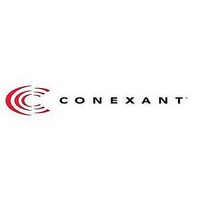bt865a Conexant Systems, Inc., bt865a Datasheet - Page 62

bt865a
Manufacturer Part Number
bt865a
Description
Ycrcb To Ntsc/pal Digital Video Encoder
Manufacturer
Conexant Systems, Inc.
Datasheet
1.BT865A.pdf
(71 pages)
Available stocks
Company
Part Number
Manufacturer
Quantity
Price
Part Number:
bt865aKPF
Manufacturer:
CONEXANT
Quantity:
20 000
Company:
Part Number:
bt865aKRF
Manufacturer:
Conexant
Quantity:
416
Part Number:
bt865aKRF
Manufacturer:
CONEXANT
Quantity:
20 000
PC Board Considerations
3.5.6
3-8
Luminance Delay on CVBS/B
inductor itself may induce 1% (0.1 dB) loss, and worst case subcarrier attenuation
(including sinx/x loss) may be 7% with 10% tolerance reactive components. Any
additional ferrites introduced for EMI control after termination should have less than
5 Ω impedance below 5 MHz to minimize additional losses. The capacitor to ground
at the Bt864A/Bt865A output pin is compensated for the parasitic capacitance of the
chip plus any protection diodes and lumped circuit traces (about 22 pF+5 pF/diode).
Some filter peaking can be accomplished by splitting the source impedance across the
reactive PI filter network. However, this will also introduce some chrominance-
luminance delay distortion in the range of 10–20 ns for a maximum of 0.5 dB boost at
the subcarrier frequency.
The filter network feeding an RF modulator may include the aforementioned trap,
which could take two forms depending on the depth of attenuation and type of
resonator device employed. The RF modulator typically has a high input impedance
(about 1 KΩ ± 30%) and loose tolerance. Consequently, the amplitude variation at the
modulator input will be greater, especially when the trap is properly terminated at the
modulator input for maximum effect. Some modulators video or aural fidelity will
degrade dramatically when overdriven, so the value of the effective termination
(nominally 37.5 Ω) may need to be adjusted downward to maintain sufficient linearity
(or depth of modulation margin) in the RF signal. Where required to maintain better
than 40 dB audio dynamic range in the presence of video energy in the region of the
aural carrier, a two section trap with more than 20 dB attenuation may be warranted.
Best gain flatness versus frequency and luma-chroma delay match can be obtained by
active buffering and use of the variable luma delay on CVBS/B channel. See
Figure
Postfiltering of the video signal can introduce a variable delay between the lower
frequency luminance components and the higher frequency chrominance subcarrier
components. The group delay distortion is often specified in system as chroma-luma
delay inequality or as Sinx/x pulse group delay. Group delay distortion is commonly
induced by postfilters which peak the chrominance level, by trap circuits intended to
reduce video energy in the aural subcarrier frequency range, and by Vestigial
Sideband (VSB) filtering in RF tuners. Since oversampling encoders greatly reduce
the need for peaking filters, delay compensation of the luminance signal largely
benefits the channel through the RF modulation and tuner path where group delay
distortion can amount to several hundred nanoseconds or several pixels of
misregistration.
While flat group delay correction as observed from a Sinx/x pulse spectrum can
require several LC stages with active buffers, a simplified approach where only luma-
chroma delay must be equalized is to shift the luminance signal through pipeline
delays to match any additional group delay induced on the chrominance components
by postfiltering. This alignment of the lower frequency luminance components with
the chrominance components does not strictly satisfy broadcast quality requirements
but provides perceptible improvements in display registration.
While VSB delays are prescribed in ITU-R BT.470-3 as about 170 ns, the luminance
delay compensation for postfilter aural traps depends on the attenuation required at
the aural carrier frequency. In the case of NTSC signals sampled at CCIR601
resolution, the coincidence of the aural carrier (4.5 MHz) at one third of the sample
rate means that any video component which transitions at intervals of every third pixel
3-1.
Conexant
Bt864A/Bt865A Data Sheet
100138C
02/17/03













